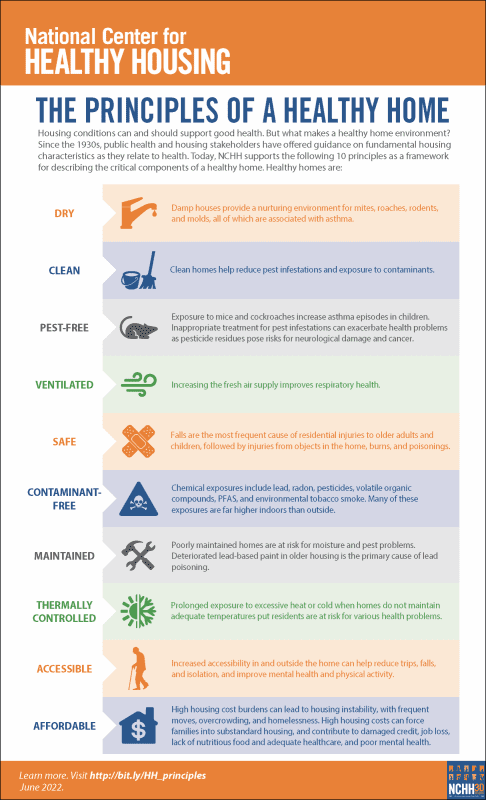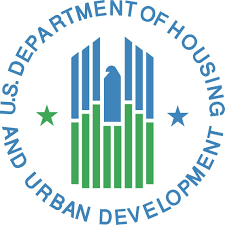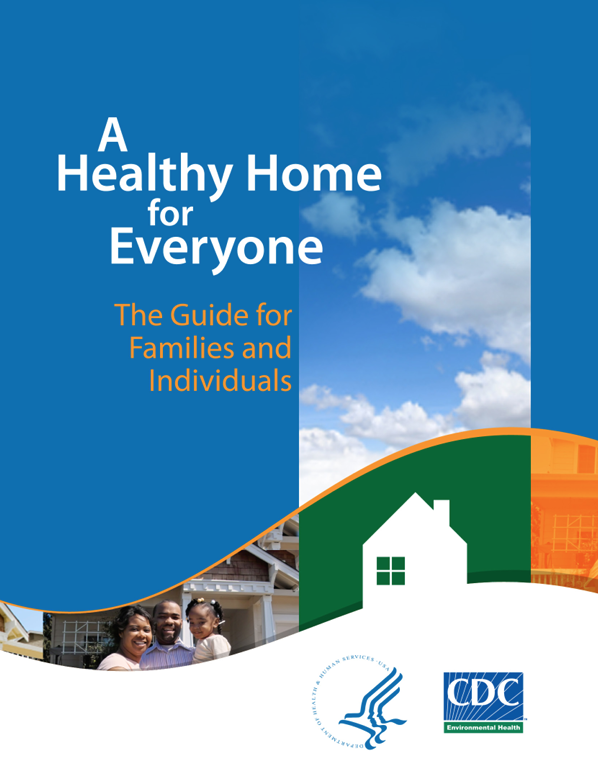The conditions of the homes we live in can impact our health: a healthy home should support good health by being by dry, clean, safe, ventilated, free of pests and contaminants, well maintained, and thermally comfortable. In addition, homes should be affordable and accessible to all people, regardless of age or ability.
The Surgeon General defines Healthy Homes as dwellings that are sited, designed, built, renovated, and maintained in ways that support the health of residents, whilst California's Health & Safety Code (Section 17920.3) specify that a healthy home is a structure that is free from the following substandard housing conditions:
- Moisture and mold that can cause or worsen illness or damage personal belongings.
- Pests that can cause illness or are a nuisance.
- Unsafe conditions and poorly maintained plumbing, heating and other systems that can lead to injuries and other problems.
- Unventilated areas that can increase indoor pollutant levels.
The National Center for Healthy Housing (NCHH) estimates that people spend at least 50% of their time each day inside their home, suggesting that the condition of the home is a factor in a person's well-being.
The NCHH provide 10 principles that can be used a framework for describing the critical components of a healthy home, where a home should be: dry, clean, pest-free, ventilated, safe, contaminant-free, maintained, thermally controlled, accessible, as well as affordable.
Tracking exposures in the home and related health problems can help individuals, communities, researchers, and public health officials to understand how living conditions impact health and identify ways to promote healthier housing.
This information can also help doctors, researchers, and public health officials understand how our homes can be improved to help us stay healthy.
What is a Healthy Home?
The 10 principles described in greater detail below provide a framework for describing the critical components of a healthy home.

Common Indoor Hazards in California
People can come into contact with hazards inside their homes, such as toxic metals, pests, and mold.
Lead
Lead is one of the most common hazards in the home. Lead poisoning is also the most common environmental illness among California children and is preventable.
Lead is known to be toxic to the human body even at low levels. It impairs the development of the nervous system and causes damage to other organs. Even small amounts may cause lifelong learning and behavior problems.
Lead was commonly added to residential paint in houses built before 1950. At that time the lead content in paint was as high as 50% by weight. This practice caused lead poisoning of millions of children, mainly in low-income families.
Although lead-based paint was banned for use in housing in 1978, homes and other buildings constructed before the ban may still contain lead-based paint. Whether these homes are renovated, or the paint simply deteriorates, these older homes pose a threat to children living in them.
To learn more about the percentage of homes built before 1950 in California, explore the age of housing data from the National Environmental Public Health Tracking Network.
Radon
Radon is a naturally occurring, odorless, radioactive gas formed by the breakdown of uranium found in soil, rocks beneath and around building foundations, and some building materials.
Radon is a gas and can enter homes and buildings through cracks in concrete floors and walls, the basement or crawl space, floor drains, or through well water.
Any home may have a radon problem, new or old. Radon from soil is the main source, but in rare cases radon can also be found in drinking water. Health risks from radon in drinking water are lower and are only a significant concern in certain parts of the country.
Pests and Pesticides
Infestations of pests are particularly harmful to residents. Cockroach and rodent allergens in homes can cause asthma or trigger asthma attacks.
However, pesticide-based treatment of pest infestations can exacerbate health problems, since pesticide residues in homes pose the risk of neurological damage and cancer.
Carbon Monoxide
Over 50% of exposures to carbon monoxide occur in the home. CO exposure and poisoning can occur from using poorly maintained or unvented heating equipment, warming up vehicles in garages, using a gas stove or oven to heat the home, leaving chimneys clogged or blocking heating exhaust vents, running generators or gas-powered tools in enclosed areas or near windows, doors, or vents.
Indoor Asthma Triggers
The Institute of Medicine identified the association between biological and chemical exposures in the home with asthma. As much as 40% of excess asthma risk in minority children may be attributable to exposure to residential allergens such as mold, dust mites, and cockroaches.
Racial and ethnic disparities in asthma morbidity may partly be due to substandard housing and poverty. Substandard housing is more likely to have excessive moisture and dampness, structural deficits, poor ventilation, deteriorated carpeting, and cockroach/pest problems, all of which create indoor environmental conditions that may cause asthma or may trigger an asthma episode.
Indoor triggers or exposures associated with asthma attacks include: cockroaches, dust mites, pet dander, secondhand smoke, and mold or other fungi.
Dampness and Mold
Dampness, mold and moldy odor are all signs of excessive moisture, water intrusion, and/or poor ventilation, and signal potential health risks for occupants. Excess moisture also provides a more attractive environment for pests, such as cockroaches and rodents.
Dampness and mold are most often linked to asthma but have also been connected to a range of respiratory conditions such as allergies. Under certain conditions some molds can produce toxins called mycotoxins, which can cause serious illness.
Who is Vulnerable to Unhealthy Homes?
Although housing is used by the whole population, low income families, and particularly children and the elderly, suffer disproportionately from substandard housing.
Childhood lead poisoning, respiratory diseases, and injuries have all been linked to substandard housing. There are more than 6 million substandard housing units nationwide.
While anyone can encounter hazards in the home, some people are at even greater risk due to:
- Housing policies: Lack of affordable housing, substandard housing conditions, and housing/tenant displacement.
- Social conditions: Limited income, limited education, language barriers, immigration status, and overcrowded living environments.
- Age and physical status: Children, the elderly, mentally ill, medically frail, and chronically ill.
It is the owner or landlord's responsibility to fix substandard housing conditions. Many of these problems can be avoided or improved with proper home upkeep and free- or low-cost solutions. Renters may ask local city or county code enforcement agencies for help if landlords do not repair or remediate these conditions in a timely way once they have been informed.
To learn more about vulnerable communities in California, explore population data from the National Environmental Public Health Tracking Network.
Healthy Homes and Regulation
Many factors that affect housing quality can be addressed by changes in policies related to the siting of housing, code enforcement, what building materials to use, and rehabilitation of existing units. Legislative policy has targeted healthy homes issues, yet effectiveness may vary by level of local implementation, enforcement, or funding.
Proper enforcement of current housing codes can address many issues that contribute to unhealthy homes. Owners have a responsibility to ensure the property is habitable. It must be fit to live in. In legal terms, "“habitable"” means that the unit is fit for occupation by human beings and that it substantially complies with state and local building and health codes that considerably affect tenants’ health and safety.
Building Codes and Health Codes are there to ensure the quality of buildings people will use, and local jurisdictions then provide inspectors whose job it is to enforce those laws. Typically, cities enforce the building codes, and a county health department enforces the health codes. This may vary by jurisdiction.








